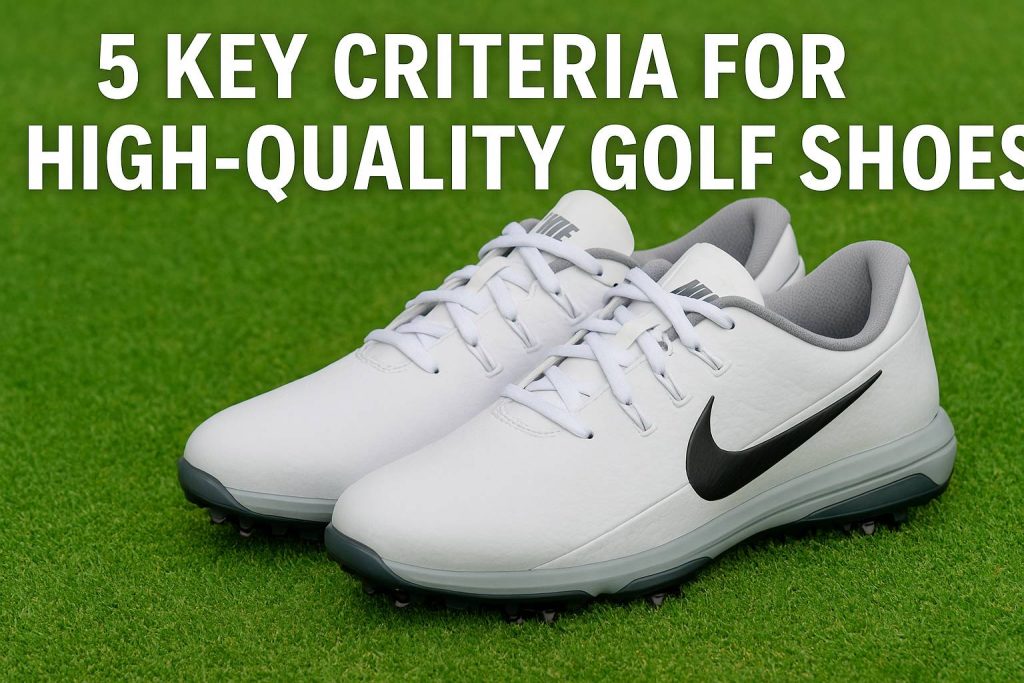In the game of golf, comfort and stability while walking across the course play a critical role in overall performance. Golf shoes are more than just style accessories—they are essential gear that supports each step, swing, and body rotation of a golfer. Therefore, choosing the right pair of high-quality golf shoes should never be taken lightly.

Below are the key criteria to consider when selecting golf shoes that ensure comfort, safety, and peak performance on the course, according to GoGolf.
1. Comfort: The Fundamental Element in Golf Shoes
Great golf shoes must offer maximum comfort from the moment they are worn until the end of the game. Although golf doesn’t involve high-impact movements like running or jumping, it does require players to stay on their feet for extended periods—often 4 to 6 hours per round (18 holes). This means the shoes need to support long walks, prolonged standing, and maintain stability during every swing.
Key comfort features in golf shoes include:
- Ergonomic design that follows the natural contours of the foot, preventing blisters or pressure points.
- Cushioned insoles, often made from EVA foam or memory foam, that absorb shock and provide comfort on uneven terrain.
- Ventilation systems or mesh panels that allow airflow and reduce moisture build-up inside the shoes.
- Arch support, especially for players with flat feet or high arches, to reduce fatigue.
It’s also important to match the shoe size with foot width. Many quality golf shoe brands offer wide-fit options to ensure a proper fit without squeezing the feet.
2. Quality Materials: Weatherproof, Lightweight, and Breathable
The materials used in golf shoes must serve three main functions: withstand changing weather conditions, be lightweight, and offer good breathability. Common high-performance materials used in quality golf shoes include:
- Premium synthetic leather or waterproof natural leather, which provides protection during damp or rainy conditions.
- Mesh or knit uppers, which are lightweight and breathable—perfect for playing in hot weather.
- Gore-Tex membranes or similar technologies, which keep the shoes waterproof while allowing airflow from inside to outside.
Shoes that block water but maintain thermal comfort are essential, especially in tropical climates like Indonesia, where humidity and sudden rain are common.
Players should also consider shoe weight. Even if a shoe appears solid and sturdy, it should still feel light on the feet over long hours of play. Outsole materials like TPU (thermoplastic polyurethane) are often used for their combination of strength and lightness.
3. Traction: The Key to Stability During Swings
Traction or grip is a crucial yet often overlooked element in golf shoes. An optimal golf swing requires stable foot positioning. During a swing—especially the backswing and follow-through—the body undergoes rotation. Without proper grip, players can lose balance or even slip.
There are two main grip systems in golf shoes:
- Spiked – Featuring replaceable plastic spikes embedded in the outsole, ideal for wet or slippery conditions.
- Spikeless – Relying on anti-slip tread patterns. These shoes are lighter, more flexible, and suitable for casual play, even allowing players to transition from course to clubhouse without changing shoes.
Choose golf shoes with outsoles specifically designed for course terrain—not as hard as soccer cleats, but firm enough to grip the ground when shifting body weight. Leading brands often use multi-directional traction designs to maintain optimal grip across fairways, roughs, and bunkers.
4. Ankle Support: Protecting Posture and Preventing Injury
Body rotation during a golf swing places pressure on the feet, especially the ankles. Therefore, golf shoes should provide stable ankle support to avoid injuries or discomfort that could impact performance.
Shoes with a mid-cut design, slightly higher than regular shoes, offer added protection around the ankle. Additionally, lace lock systems or automated closures like BOA lacing systems help secure the foot in a safe position throughout play.
Additional features that support ankle stability include:
- Firm heel counters to keep the heel from shifting during swings.
- Elastic sockliners, making the shoes feel like an extension of the foot.
- Lateral side padding to prevent unnecessary foot shifts when transferring weight from one foot to the other.
Good ankle support also helps maintain proper posture during swings and prolonged standing on the course.
5. Lightweight and Fatigue-Reducing
Lastly, but just as importantly, is the overall weight of the golf shoes. Heavy shoes can lead to fatigue—especially since golfers typically walk 7–8 kilometers during a single round.
Lightweight shoes help conserve energy, maintain focus, and reduce the risk of muscle fatigue in the calves, soles, and hips. These shoes typically feature:
- Modern mesh or knit uppers, which are light yet durable.
- Outsoles made from EVA foam or injected TPU, which are not only lightweight but also responsive to pressure.
However, lightness should not come at the cost of stability. Ensure the shoe still offers solid structural support—particularly in the heel and midsole—to safely handle dynamic movements.
Conclusion
Choosing a good-quality golf shoe isn’t just about style or brand—it’s a strategic decision that affects a golfer’s comfort, performance, and safety on the course. Ergonomic design, weather-resistant materials, strong traction, ankle support, and lightweight construction can greatly enhance the playing experience.
Golf shoes are not just footwear; they are an extension of the player’s body, supporting every step and swing. Therefore, invest in shoes that truly match your needs—not just by appearance, but through function and comfort.
[ Follow our social media Account: GoGolf Instagram | GoGolf Facebook | GoGolf X ]











